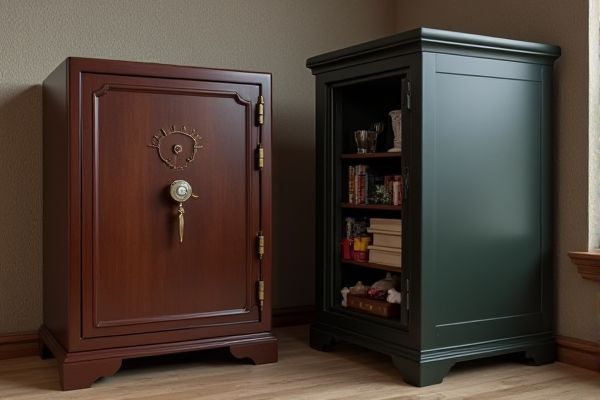
Cabinet safes offer convenient storage and moderate security, ideal for smaller valuables and quick access, while floor safes provide enhanced protection against theft and fire by being installed securely into the ground. Explore the rest of the article to determine which safe best suits your security needs and lifestyle.
Table of Comparison
| Feature | Cabinet Safe | Floor Safe |
|---|---|---|
| Installation | Mounted in walls or secured inside furniture | Recessed into the floor; requires professional installation |
| Security Level | Moderate; depends on wall strength and mounting | High; concealed and harder to access or remove |
| Accessibility | Easy to access at waist or chest height | Less convenient; located on the floor |
| Space & Capacity | Varies; generally larger interior space | Limited by floor space; usually smaller capacity |
| Durability | Sturdy but exposed to wall damage | Very durable; hidden and protected by concrete or flooring |
| Ideal Use | Documents, valuables, firearms in easy reach | Highly sensitive valuables demanding concealment |
| Price Range | $150 - $1000+ | $300 - $2000+ |
Overview of Cabinet Safes and Floor Safes
Cabinet safes provide secure storage with ease of access, designed for installation inside cabinets or closets, ideal for protecting documents, valuables, and firearms. Floor safes offer enhanced security through heavy-duty construction and are embedded into the floor, making them resistant to tampering and theft. Both types prioritize fire resistance and locking mechanisms, but floor safes deliver superior protection against forced entry due to their concealed and anchored installation.
Key Differences Between Cabinet Safes and Floor Safes
Cabinet safes are designed for easy access and organization, typically installed in accessible locations like closets or offices, while floor safes provide enhanced security through discreet installation beneath floor surfaces, making theft more difficult. Floor safes often feature thicker steel and higher resistance to drilling and fire, offering superior protection against unauthorized access and environmental damage. Your choice depends on whether convenience and organization or maximum security and concealment are your primary priorities.
Security Features Comparison
Cabinet safes often feature reinforced steel construction with advanced locking mechanisms such as biometric or electronic keypad locks, providing high resistance to tampering and unauthorized access. Floor safes typically offer superior protection against fire, flooding, and burglary due to their ability to be anchored securely beneath the floor, making them harder to detect and remove. Both safes incorporate pry-resistant doors and drill-resistant plates, but floor safes generally deliver enhanced concealment and impact resistance.
Installation Requirements and Methods
Cabinet safes typically require mounting to walls or furniture using bolts or screws, making them easier to install in existing structures with minimal floor space impact. Floor safes, by contrast, demand cutting into the floor and securing the safe within concrete or reinforced flooring, offering enhanced security but requiring professional installation and more extensive modifications. Your choice depends on the balance between installation complexity and desired protection level for your valuables.
Space and Accessibility Considerations
Cabinet safes offer convenient accessibility with easy-to-reach storage compartments, making them ideal for frequently accessed valuables in home or office settings. Floor safes maximize security by being concealed beneath flooring, requiring more effort to access but saving room in limited spaces. Choosing between cabinet and floor safes depends on balancing the need for quick accessibility against discreet, space-efficient protection.
Cost Analysis: Cabinet Safes vs Floor Safes
Cabinet safes generally offer a lower initial cost compared to floor safes due to simpler installation requirements and thinner steel construction, making them suitable for light to medium security needs. Floor safes, typically made from thicker steel with heavier bolts and requiring professional installation, cost more upfront but provide enhanced protection against burglary and environmental damage. Long-term value analysis favors floor safes when factoring in durability, resistance to forced entry, and fire protection, outweighing the higher initial investment for higher security demands.
Pros and Cons of Cabinet Safes
Cabinet safes offer convenient storage with easy access, making them ideal for securing documents, electronics, and small valuables in office or home settings. Their lighter construction compared to floor safes allows for easier installation but may compromise resistance to theft or fire, presenting a trade-off in security. While cabinet safes provide organized protection, they are more vulnerable to forced entry and may not offer the same level of durability or concealment as floor safes.
Pros and Cons of Floor Safes
Floor safes offer enhanced security by being discreetly installed beneath the floor, making them harder to detect or remove during break-ins. They provide excellent fire and water protection, but installation requires professional work and may not be feasible in all floor types, limiting portability. However, access can be less convenient compared to cabinet safes, especially in emergency situations.
Best Uses and Ideal Placement Scenarios
Cabinet safes are best suited for storing valuables in accessible locations such as home offices or bedrooms, offering moderate protection and ease of access. Floor safes provide enhanced security by being installed flush with the floor, ideal for concealing high-value items in discreet areas like closets or under heavy furniture. Your choice depends on the balance between accessibility and security, with cabinet safes favoring convenience and floor safes prioritizing concealment and theft resistance.
How to Choose Between Cabinet and Floor Safes
Choosing between a cabinet safe and a floor safe depends on your security needs, space availability, and installation preferences. Cabinet safes offer easier accessibility and are ideal for storing documents and valuables in an organized manner, while floor safes provide enhanced protection against theft and fire by being concealed and bolted to the ground. Consider your priorities for convenience, security level, and the type of items you want to protect to determine which safe best fits your requirements.
 homyna.com
homyna.com